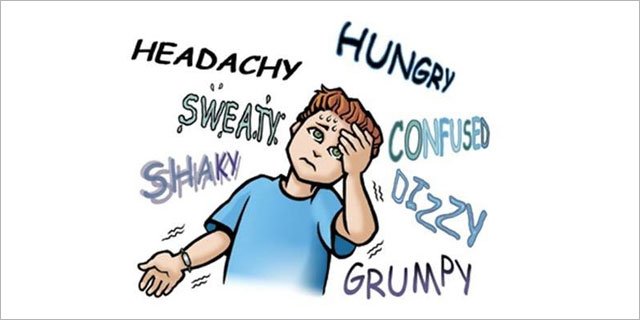
Severe hypoglycemia is characterized by low levels and a disturbance in blood sugar (blood glucose). Because all body tissues, especially the brain for glucose as a primary energy source, need to disrupt blood sugar, proper brain activity. When someone is in a state of hypoglycemia, he feels dizzy, headache, confusion in vision, difficulty concentrating, and other neurological symptoms. If the blood sugar level drops to a lower level, the hormone causes epinephrine and Norepinephrine, which help the body regulate blood sugar levels. Because of the secretion of epinephrine and Norepinephrine, the symptoms of acute hypoglycemia increase. The patient may feel chills, copious sweating (Diaphoresis), an increase in heart rate, anxiety and hunger.
Severe hypoglycemia, or hypoglycemia, occurs mainly in people with diabetes. Among these patients, hypoglycemia can occur as a result of excessive consumption of anti-diabetic drugs (Insulin, Insulin) or because of diet changes and sports. Having a healthy person follows a healthy diet, doing a sports activity that helps to lower the sugar level, and in turn increases your intake of sugar. This occurs faster in diabetic patients who are more sensitive to blood sugar. Hypoglycemia and its associated symptoms are more common in people with diabetes who are treated with insulin injections or insulin-stimulating pancreatic drugs such as sulfonlurea or meglitinides, such as repaglinide, .
The main conditions that cause hypoglycemia to be treated with these drugs are the lack of appropriateness between the time and dose of medication, the amount of food and physical activity. Insulin given or excreted by drugs, enters the sugar of the cells and leads to a decrease in blood level. Sports activity also leads to sugar entering the cells and to an additional reduction in sugar level. If we add to these things, too, the lack of eating that would prevent the sharp drop in sugar, then this will lead to hypoglycemia and the emergence of symptoms characteristic of this situation. Education is designed to prevent hypoglycemia by self-monitoring of sugar level, the suitability of dosage doses for the measured values of the activity performed, in addition to the amount and type of food consumed, all of these steps will significantly prevent the symptoms of hypoglycemia, May also be dangerous.
Causes and risk factors
The blood sugar level remains generally within the range of 80-120 mg / dL. In women, this value may be 15-20 mg or more. These symptoms appear in healthy people, when blood sugar values reach 40-50 mg / dL, and people with diabetes may begin to appear with higher sugar values of 90-100 mg / dL and above according to the low sugar and initial sugar levels. The higher the initial sugar level and the faster the sugar, the lower the sugar symptoms. The initial feeling of hypoglycemia stems from the activation of the autonomic autonomic nervous system (Sympathetic) and Parasympathetic. Excessive activity of this device is characterized by the following symptoms: Restlessness, sweating, trembling, hunger and palpitations.
The activation of the autonomic nervous system when the sugar level is low is actually a mechanism of defense for the body, which aims to warn that there is a decrease in the level of sugar, and thus lead the person with these symptoms to discover the matter and eat, and thus inhibits an additional drop in sugar level and restore its level of sound value.
If no independent symptoms are detected, and the condition is not corrected by eating or eating sugar, the blood sugar level will continue to decline. Central symptoms and signs (hypoglycemia-Neuroglycopenic) caused by hypoglycemia will appear in brain cells. Symptoms include one or more of the following: headache, confusion, drowsiness, speech disturbance, blurring of vision, strange or violent behavior, decreased consciousness, seizures, symptoms of a cerebrovascular accident, Paralysis of the body part, and ultimately coma.
After the independent device is activated as a reaction to hypoglycemia, the body secrete additional hormones, including glucagon and other hormones, cortisol and growth hormone. These hormones, to analyze the stores of sugar in the liver and muscles, and to release sugar from these stores of blood, prevent the entry of additional amounts of sugar to cells, and also stimulates the production of sugar by the liver from raw materials, reaching it from the muscles and fat (amino acids caused by muscle analysis , Glycerol (Glycerol) resulting from analysis of fat cells). If there is a defect in the secretion of these hormones, or when the failure to respond to eating with the warning given by independent symptoms, then may be the symptoms of central hypoglycemia.
From here, we see that the most effective treatment for hypoglycemia, is to take sugar immediately when the emergence of independent symptoms. 15-20 grams of glucose (sugar) available, will lead to high blood sugar level and return to the right direction. This amount of sugar is found in 3-4 teaspoons of sugar, half a cup of natural juice, a cup of cola, two tablespoons of raisins and one teaspoon of honey. If the person with hypoglycemia is not fully aware, glucagon should be administered by injection or given intravenous glucose solution (by a medical staff).
The causes of hypoglycaemia in non-diabetic patients include diseases that prevent the release of hormones stimulating the production and release of blood sugar, such as Addison's disease, which damages the production of cortisol (pituitary gland), which prevents the other Cortisol secretion, and pancreatic injury, such as pancreatitis or tumors in the pancreas, leading to impaired glucagon secretion; Serious malnutrition, so that there is no basic building blocks to produce sugar, excessive alcohol consumption that prevents the production of sugar in the liver, liver diseases, such as viral hepatitis or tumors in the liver also prevent the production and excretion of sugar from the liver, the blood. In rare cases, pancreatic insulin tumors develop in the pancreas (Insulinoma / Insulinoma) which lead to hypoglycemia. In this case, the treatment is to remove the tumor.